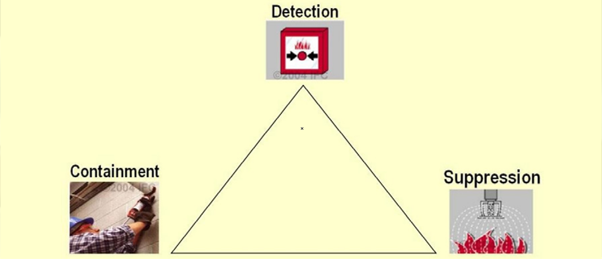Saving Lives And Property Through Passive Electrical Fire Containment (passive Fire Protection)
Mr. Arul Prakash Kitherian (Managing Director),
OBO Bettermann India Pvt. Ltd.
General Principle for Fire Safety (Compartmentation)
The spread of fire can be restricted by dividing a building into separate compartments with fire sealants and fire-resistant walls and floors, thereby, increasing the availability of escape routes for occupants.
Often, it is just carelessness—a forgotten candle, an unextinguished cigarette, or a technical defect— that triggers a catastrophe. Often, it only takes a moment for a flame to become a fire, from the first glow to a huge inferno. There are a large number of practical risks and sources of ignition, i.e., overheating or overloading of electrical components and cables, electrical faults, lightning, vibration, and electrical leakages. On the whole, India has been moving forward in the reduction of fire accidents year over year. As per the National Crime Records Bureau, there were on average 22,500 fire accidents reported between 2001 and 2014, but as per the latest report, there were only 11,000 fire accidents reported in 2019. With a lot of concerted efforts from the government of India and other industry bodies like IEEMA, FSAI, FPAI, etc. the incidents of fire accidents is on the decline.
In fire science, the tetrahedron parameters of the fire triangle are considered fuel, heat, oxygen, and chain reaction only, but actually, fire extinguishment is done by the detection of smoke, flame, and heat by detectors. The fire-detected signal would go to the fire alarm panel, triggering the hooters. This is the way it is alerting the occupants and allowing them to go away from the fire to the safe assembly point through the emergency and rescue route. In addition to that, the trigger would activate the solenoid valve of the fire suppression system, and the valve of the clean agent gas would open and put out the fire.
Passive fire protection is the process of fire prevention. The fire-retardant coating applied over the electrical cable would stop the fire at the initial stage itself. When the fire happens through other means, it is compartmentalized and prevented from spreading. Most fire accidents happen due to electrical short-circuits. The passive fire sealants help prevent the spread of fire from one compartment to another. The other passive fire products are fire protection mortar, fire protection foam and fibre soft boards, and other fire intumescent blocks. These sealants are applied wherever electrical conduits are penetrated through walls, floors, and ceilings. In addition to that, sealants are also applied through HVAC ducts and sanitary pipes.

As per a report on fire accidents in India, 40 percent of the damage is caused by direct fire and 60 percent by indirect fire, i.e., heat, smoke, water, etc. In many places, compliance is considered important, but the actual fire safety system seems incomplete. This is because of the lack of awareness about passive fire products and the use of sub-standard electrical products available in the market.
In the case of protecting a data-centric enclosure, a fire suppression system is recommended. But before installing the fire suppression system, as per the guidelines of NFPA 2001, a room integrity test shall have to be conducted. In many places, suppression systems are installed without conducting a room integrity test. The importance of a room integrity test is to detect holes and gaps in the room and seal them with appropriate passive fire sealants. Actually, the walls, ceiling, and floor have holes for inserting electrical and data cables, plumbing, and other sanitary pipes. If the holes and gaps (around the pipes and cut-outs) of the room are not properly sealed with fire-rated sealants and passive fire protective products, the entire clean agent gas would be wasted without doing any fire suppression. Actually, the duration of the agent discharge as per NFPA 2001 is only 10 seconds. Within this precious time, if the fire is not contained, it will spread rapidly and cause huge losses in lives and property. The very purpose of installing a suppression system will not be fulfilled. Active fire protection and passive fire protection complement each other.

Why do we require passive fire protection?
This is the question on the minds of many. There are some problematic issues that can lead to failure due to defective fire suppression systems, i.e., power outages, emergency power failures, system malfunctions, system failures during fires, and human error. In addition to these issues, another set of problems related to defective active fire systems like pre-existing sprinkler heads, i.e., closed valves, insufficient water pressure, external problems, and microorganisms in the water lines can cause pipes to corrode, leading to sedimentclogged lines and improper installations. In the case of passive fire protection, it does not require electrical power, and hence, in the event of failures of the fire detection system and fire suppression system, the passive fire protection would stand tall and fight fires for a specific period of time. Hence, passive fire resistance is related to the protection of human lives and properties. The structural elements of a room are created to separate human beings from fire; these can be fire sealants, fire-rated walls, fire-rated doors, and smoke barriers. Protected openings in these walls shall be made out of fire-stopping and flame-retardant materials. It plays a vital role in protecting human life.
One survey says approximately 95% of the victims of thefires were poisoned by smoke. In the majority of high-rise buildings in India, 95% of all cable insulation is made out of PVC material. During fire accidents, 1kg of PVC will fill a volume of 500 cu m with thick black smoke. It consists of hydrochloric acid fumes, cyanide, sulphur dioxide, carbon dioxide, ammonia, etc. It will be very difficult to reach the exit signage from there to go to the emergency exit route because the visibility is limited to 12 feet maximum and the eyes are burning. In addition to the corrosive fire gases created during fires, they cause immense damage to property and can permanently damage the structure of buildings. Therefore, halogen-free installation systems (e.g., fire-rated junction boxes) should or must always be used in public areas (emergency routes, lifts, etc.). The chemical composition of these halogen-free systems is designed in such a way that, in the case of fire, they produce approx. 8 times less hazardous (toxic or corrosive) gases than PVC, which would reduce the risk of harm to people and property to a minimum.

In a server room, UPS room, etc., there are openings for electrical cable penetration, plumbing, and other sanitary piping. During a fire accident, the fire-resistant chemical products provided in the openings would expand seven times their original size upon heating and limit the transfer of flame, heat, and smoke out of the room.
Passive fire protection targets three aims, i.e., to limit the spread of fire, protect the escape and rescue routes, and perform maintenance—important electrical systems must continue to function. Actually, it takes 30 minutes for the occupants in the building to escape through the emergency exit route and for the rescue team to come in and rescue the elderly and disabled to the assembly point. Till that time, the lighting, smoke excavation unit, and ventilation unit for the emergency exit route should be functional, for which an electrical system with fireproofing is necessary. In addition to this, providing a fire-rated passive fire protection system is paramount. A further 90 minutes of power supply is required for exit signage, a fire alarm panel, and a fire lift, and then only rescue personnel can come in and fight fires effectively.
National Building Code 2016, Part 4, Annexure C reference
The terminology of fire stop compartmentation defines a ”fire compartment as ”a space within a building that is enclosed by a fire barrier of fire-resistant walls on all sides, including top and bottom”. As mentioned in Cl. 2.20, 2.21, 4.5a, 4.8, and 1.9 of NBC 2016 Part 4, the fire barrier is defined as ”a designed and constructed member with a specified fire resistance rating to limit the spread of fire that also restricts the movement of smoke”. In another clause, it stresses the use of a fire barrier. At some distance, these barriers need to be penetrated for duct work, plumbing, and electrical systems, and in such cases, the use of passive fire protection measures shall be made so that the integrity of these barriers is not compromised.
As per Cl. 4.8, page 40 of the National Building Code 2016, Part 4, there shall be a fire-resistant wall (passive fire protection), segregated between transformers, having a fire rating of 120 minutes, as a fire explosion or smoke therefrom is likely to interfere with safe egress from the building.
National Electrical Code 2023: IEC/IS 61936, reference
The code stressed that all wiring systems that pass through the building construction, such as floors, walls, roofs, ceilings, partitions, etc., shall be sealed after the passage of wiring systems and pipes to avoid spreading fire and smoke. This is to be followed in pneumatic and sanitary pipe openings as well, complying with standard fire-rated sealings.

In the field of construction, a lot of emphasis is placed on the use of non-combustible substances and components. In addition, systems are arranged in such a way that fire sections of a manageable size can be formed according to the risks. Spatial separation and compartmentation through construction measures is a very effective measure in the prevention of the spread of fires to the other areas of building and systems. If structural separation is not possible, other measures can be used. For example, installations can be safely shielded with plate material or routed in fire protection ducts. Coating can be applied to supports and can form an insulation layer in case of fire.
Conclusion
A comprehensive fire protection concept is required when designing a building or an industry to help prevent fires and guarantee protection of property and lives. Enforcement of the code will definitely guarantee this and it is the moral responsibility of the planners, builders and occupiers to ensure this is implemented. The attitude that fire is a natural calamity or a God’s act should be trashed and responsibility assumed by all individuals in order to further minimize the NO of fire related accidents.
